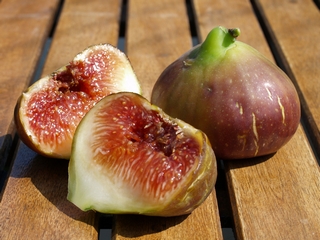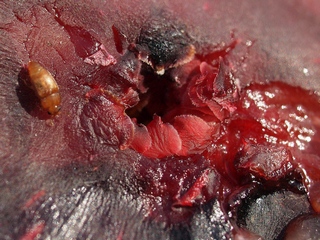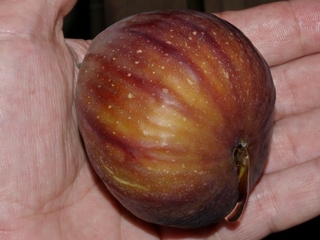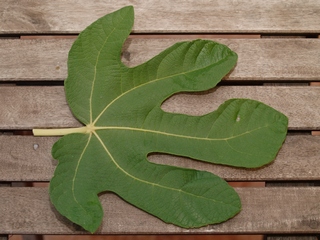
La Madeleine des deux saisons sur ma terrasse.
17 août 2008.

La Madeleine des deux saisons sur ma terrasse.
31 juillet 2011.

Dégâts causés par les Carpophilus surtout avec les
variétés dont les ostioles sont très ouvertes, les bactéries
qu’ils ont associées causent la pourriture des figues
Autofertile (parthénocarpique)
Bifère (Figues-fleurs début juillet, figue d’été début août)
Nous le trouvons décrit par Ira Condit dans Hilgardia avec beaucoup de détails et quelques contradictions.
Figuier typiquement français. Il s’adapte bien à la plupart de des régions françaises.
Si on veut cueillir des figues sous des climats avec des automnes froids, les figuiers bifères sont presque indispensables.
Caractéristiques de l’arbre :
Arbre de vigueur modérée, port à tendance érigé.
Feuilles épaisses majoritairement trilobées.
Il a tendance à perdre beaucoup de figues. Il est possible qu'il ait besoin du blastophage pour sa pollinisation.
Description des fruits :
Figues-fleur très précoces, d’environ 100 g.
Peau avec tonalités de couleur marron sur fond jaunâtre.
Chair rosée. Pédoncule imperceptible.Cou petit.
Goût bon sous des conditions d’insolation suffisantes et quand les figues sont cueillies à point.
Les figues ont une forte tendance à s'ouvrir.
Figue d’été plus petite que la figue fleur, avec une couleur de peau plus uniformisée sans fond jaunâtre.
Apparence cireuse, très belle.
Chair rougeâtre et juteuse, avec un mésocarpe large et gouteux.
Oeil grand et ouvert.
Goût raffiné et bon dans les conditions de Barcelone.
N'essayez pas de comparer son goût avec d’autres variétés de figues autochtones, ça serait comme vouloir comparer le goût d’un melon Peau de Crapaud avec celui d’un Cantaloup français, ils n'ont rien à voir (tous les deux sont bons).
Les figues présentent une forte tendance à éclater. Les mouches du fruit et les carpophilus ont tendance à attaquer cette variété ce qui a pour conséquence la perte d’une grande quantité de fruits.
Page traduite avec la collaboration de Nadia Habib.
IRA Condit (The Fig)
In many common figs, such as San Piero, Brunswick, and Madeleine, the mature
flowers do not fill the cavity, and the pulp is therefore hollow at the center.
The pulp constitutes about 83 per cent of a mature fig.
Eissen.
Angelique
Courcourelle blanche; Angeliqne blanche; Melette: La Melette (Roz.) according to Duhamel.
Medium, 1 ¾ inch, pyriform, longer than wide, ribs prominent: color yellowish white with long greenish spots. Pulp white, in center fairly rose. Leaves 3-lobed, crenate, lobes pointed, a good fig of fine flavor. Paris and Provence.
Coucourele Brune
Brown Coucourel; Coucourelle Brune (Melette); Ficus fusca Risso; Courcourellos Brunos Provence).—Two crops. First crop largest, 1 ½ by 1 ¾ inches; very early. Second crop: Small or medium, roundish; color of skin deep brown, with a thick blue bloom; stalk variable in size; pulp tender, without flavor, of deep red color, shading to rose. Except for want of flavor, it is a rich fig. Requires dry soils. Common in Provence.
Magdalen
Madeleine; De la Madeleine.—Size below medium to small, about 1 ½ by 1 ½ inches, quite round, or slightly pyriform and obtuse. Ribs distinctly prominent and rough, especially toward the stalk, while diminishing in prominence toward the eye, but entirely disappearing immediately around it.
Stalk longer than one-half the fig eye open, comparatively large, but depressed: scales very small and few o. a pale whitish amber. Skin greenish-yellow or yellow on cheek, greenish in the shade; pulp amber white: meat white. A very delicious little fig. far superior to the lschias and the Celestes. (Fig. 72.)
The above description is taken from fig trees imported from France by Mr. Grillet to California and grown in Santa Clara Valley. They differ from those received by the Royal Horticultural Society of London, as seen below. Dr. Hogg gives Madeleine as synonymous with Angelique. which is erroneous,
Angelique is a distinct fig of larger size, much more flattened, and of the shape of a flat onion.
Madeleine.
De la Madeleine.—Size medium; 2 ½ inches long by 1 ¾ inches wide; pyriform: lopsided. No distinct neck and very small stalk. Ribs shallow, numerous, confluent; eye medium, open; scales large. Skin waxy, cracking, of a yellowish-green color: pulp coarse, rosy amber and pure amber toward stalk end. Vinous and juicy, but not highly flavored. Tree strong grower, with large, coarse, shallow, 3-lobed leaves, about 9 inches long by 8 wide, woolly underneath. This fig was received thus named from the Royal Horticultural Society of Loudon. It is a distinct fig from the true Magdalen.

